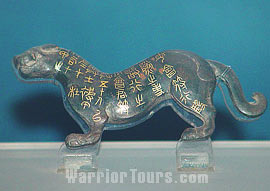Eastern Zhou

In 771 BC, King You of Haojing was murdered by a group of invading Quanrong barbarians, supported by local rebel lords. The king's son, Ping, was made emperor, and moved the capital from Haojing (Changan County in Xian City ) to Luoyi (known today as Luoyang, Henan Province). This brought about the beginning of the Eastern Zhou dynasty, so named due to Luoyi being situated to the east of Haojing.
After moving the capital east, the Zhou royal family fell into a state of decline. King Ping was not a popular ruler, thus limiting his influence over those supposedly under his jurisdiction. At the same time, other vassals were becoming increasingly powerful, strengthening their position through defeating other rival states. In 708 BC, the then Zhou king, Huan, launched an attack against Duke Zhuang of the neighboring Zheng State over issues relating to state borders. However, Duke Zhuang led a fight back, successfully defeating King Huan's army. Although the Zhou royal family officially continued to reign, in reality it was only in name, and they were ultimately succeeded by the Qin State in 221 BC.
In Chinese history, the Eastern Zhou Dynasty is divided into two parts; the Spring and Autumn Periods, between the years of 770 BC – 476 BC and subsequently the Warring States Period, between 476 BC – 221 BC.
Over 180 vassal states were recorded as existing during the Spring and Autumn Periods, among them the 'Five Hegemonies' are the most well-known, these being: the Duke Huan of Qi; the Duke Wen of Jin; King Zhuang of Chu; the Duke Mu of Qin; and the Duke Xiang of Song. Historians suggest that the Five Overlords include: the Duke Huan of Qi; the Duke Wen of Jin; King Zhuang of Chu; King Fu Chai of Wu; and King Gou Jian of Yue. The different states often sought to expand their territories through fighting with other vassals.
During this time, many of the states also focused on developing agricultural production as a means for strengthening legitimacy. As a result, iron farm tools and cattle ploughing were popularized, along with further developments made in the processes involved with bronze smelting, foundry industry and the mining industry.
In the latter part of the Spring and Autumn Periods, coins were also widely used. This stimulated the development of commerce, specifically that of the handicraft industry. The silk textiles of the Qi State and the lacquer wares of the Chu State particularly were famed for their high-degree of workmanship. Luban, a famous master artisan in Chinese history also lived during this period. Noted ancient texts including The Spring and Autumn Annals, The Book of Changes and Mo Tse were also produced at this time.
After the numerous wars of the Spring and Autumn Periods, the early part of the Warring States Period saw the establishment of ten states. The Qin, Wei, Han, Yan, Zhao, Qi, and Chu were considered the strongest, and were known as the 'Seven Warring States'. Great efforts were made by state leaders to make their respective region prosperous. A number of political reforms were introduced by the likes of Li Li, Wu Qi, and Shang Yang which aimed to make the state rich and strong. New approaches to economics and politics were introduced, along with further developments in social sciences and culture.
In agriculture, horse ploughing was adopted as common practice. Farmers also began to pay attention to the properties of soil and the processes involved with deep ploughing, which brought about the planting of different crops dependent on local conditions. Farmers also learned how to enrich soil with fertilizer, how to select better seeds, how to control plant diseases and pests and how to sow seeds depending on seasonal conditions.
Bronze-making methods were also further refined; most pieces produced during this time were light and thin, decorated with both delicate and intricate patterns. Lacquer ware developed into its own independent industry. Pieces were made from a carved-wood base, and then coated in a variety of colored lacquers, principally black, red, yellow, blue, purple and white.
The era also brought with it significant developments in the cultural sphere. A number of written works gained widespread notoriety as a result of improved publication facilities. The famous works of Qu Yuan and Song Yu produced at this time were to strongly influence authors of subsequent generations.
In the scientific arena, outstanding astronomers such as Gan De and Shi Shen contributed heavily to the advances in agriculture through their famous writings in the Gan Shi Xingjing.
During this time, both copper and gold coins started to gain widespread use. These were cast into various shapes, including that of knives, shovels as well as the more recognizable circular shape.
It was in the Warring States Period that state leaders also began to establish a centralized autocratic system of governance. The introduction of these new institutions, systems and cultural developments saw the rise of cities such as the Qi State's Linzhi (what is today known as Zibo City in Shandong Province), the Yan State's Xiadu (Yixian County, Hebei Province), the Chu State's Ying (Jiangling County, Hubei Province) and the Zhao State's Handan (Handan City, Hebei Province).

